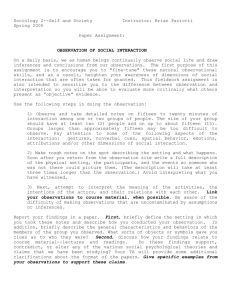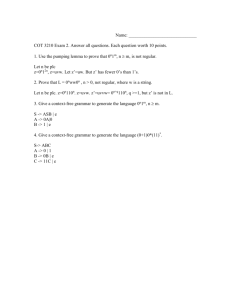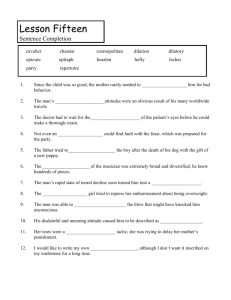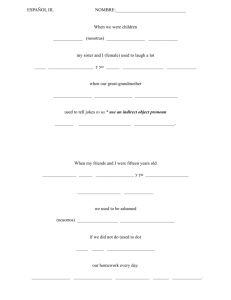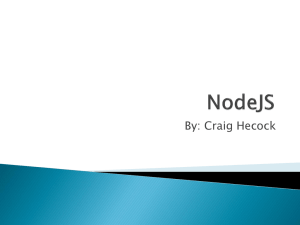A Second Look At Java
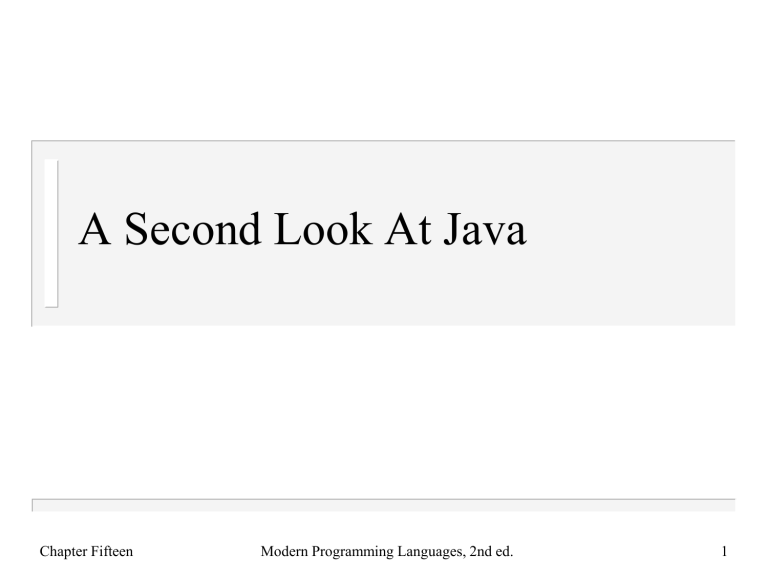
A Second Look At Java
Chapter Fifteen Modern Programming Languages, 2nd ed.
1
Subtype Polymorphism
Person x;
Does this declare x to be a reference to an object of the Person class?
Not exactly—the type Person may include references to objects of other classes
Java has subtype polymorphism
Chapter Fifteen Modern Programming Languages, 2nd ed.
2
Outline
15.2 Implementing interfaces
15.3 Extending classes
15.4 Extending and implementing
15.5 Multiple inheritance
15.6 Generics
Chapter Fifteen Modern Programming Languages, 2nd ed.
3
Interfaces
A method prototype just gives the method name and type—no method body
An interface in Java is a collection of method prototypes public interface Drawable { void show(int xPos, int yPos); void hide();
}
Chapter Fifteen Modern Programming Languages, 2nd ed.
4
Implementing Interfaces
A class can declare that it implements a particular interface
Then it must provide public method definitions that match those in the interface
Chapter Fifteen Modern Programming Languages, 2nd ed.
5
Examples
public class Icon implements Drawable { public void show(int x, int y) {
… method body …
} public void hide() {
… method body …
}
…more methods and fields…
} public class Square implements Drawable, Scalable {
… all required methods of all interfaces implemented …
}
Chapter Fifteen Modern Programming Languages, 2nd ed.
6
Why Use Interfaces?
An interface can be implemented by many classes: public class Window implements Drawable … public class MousePointer implements Drawable … public class Oval implements Drawable …
Interface name can be used as a reference type:
Drawable d; d = new Icon("i1.gif"); d.show(0,0); d = new Oval(20,30); d.show(0,0);
Chapter Fifteen Modern Programming Languages, 2nd ed.
7
Polymorphism With Interfaces
static void flashoff(Drawable d, int k) { for (int i = 0; i < k; i++) { d.show(0,0); d.hide();
}
}
Class of object referred to by d is not known at compile time
It is some class that implements
Drawable , so it has show and hide methods that can be called
Chapter Fifteen Modern Programming Languages, 2nd ed.
8
A More Complete Example
A Worklist interface for a collection of
String objects
Can be added to, removed from, and tested for emptiness
Chapter Fifteen Modern Programming Languages, 2nd ed.
9
public interface Worklist {
/**
* Add one String to the worklist.
* @param item the String to add
*/ void add(String item);
/**
* Test whether there are more elements in the
* worklist: that is, test whether more elements
* have been added than have been removed.
* @return true iff there are more elements
*/ boolean hasMore();
Chapter Fifteen Modern Programming Languages, 2nd ed.
10
}
/**
* Remove one String from the worklist and return
* it. There must be at least one element in the
* worklist.
* @return the String item removed
*/
String remove();
Chapter Fifteen Modern Programming Languages, 2nd ed.
11
Interface Documentation
Comments are especially important in an interface, since there is no code to help the reader understand what each method is supposed to do
Worklist interface does not specify ordering: could be a stack, a queue, or something else
We will do an implementation as a stack, implemented using linked lists
Chapter Fifteen Modern Programming Languages, 2nd ed.
12
/**
* A Node is an object that holds a String and a link
* to the next Node. It can be used to build linked
* lists of Strings.
*/ public class Node { private String data; // Each node has a String...
private Node link; // and a link to the next Node
/**
* Node constructor.
* @param theData the String to store in this Node
* @param theLink a link to the next Node
*/ public Node(String theData, Node theLink) { data = theData; link = theLink;
}
Chapter Fifteen Modern Programming Languages, 2nd ed.
13
/**
* Accessor for the String data stored in this Node.
* @return our String item
*/ public String getData() { return data;
}
}
/**
* Accessor for the link to the next Node.
* @return the next Node
*/ public Node getLink() { return link;
}
Chapter Fifteen Modern Programming Languages, 2nd ed.
14
/**
* A Stack is an object that holds a collection of
* Strings.
*/ public class Stack implements Worklist { private Node top = null; // top Node in the stack
/**
* Push a String on top of this stack.
* @param data the String to add
*/ public void add(String data) { top = new Node(data,top);
}
Chapter Fifteen Modern Programming Languages, 2nd ed.
15
/**
* Test whether this stack has more elements.
* @return true if this stack is not empty
*/ public boolean hasMore() { return (top!=null);
}
/**
* Pop the top String from this stack and return it.
* This should be called only if the stack is
* not empty.
* @return the popped String
*/ public String remove() {
Node n = top; top = n.getLink(); return n.getData();
}
}
Chapter Fifteen Modern Programming Languages, 2nd ed.
16
A Test
Worklist w; w = new Stack(); w.add("the plow."); w.add("forgives "); w.add("The cut worm ");
System.out.print(w.remove());
System.out.print(w.remove());
System.out.println(w.remove());
Output: The cut worm forgives the plow.
Other implementations of Worklist are possible: Queue , PriorityQueue , etc.
Chapter Fifteen Modern Programming Languages, 2nd ed.
17
Outline
15.2 Implementing interfaces
15.3 Extending classes
15.4 Extending and implementing
15.5 Multiple inheritance
15.6 Generics
Chapter Fifteen Modern Programming Languages, 2nd ed.
18
More Polymorphism
Another, more complex source of polymorphism
One class can be derived from another, using the keyword extends
For example: a class PeekableStack that is just like Stack , but also has a method peek to examine the top element without removing it
Chapter Fifteen Modern Programming Languages, 2nd ed.
19
/**
* A PeekableStack is an object that does everything a
* Stack can do, and can also peek at the top element
* of the stack without popping it off.
*/ public class PeekableStack extends Stack {
}
/**
* Examine the top element on the stack, without
* popping it off. This should be called only if
* the stack is not empty.
* @return the top String from the stack
*/ public String peek() {
String s = remove(); add(s); return s;
}
Chapter Fifteen Modern Programming Languages, 2nd ed.
20
Inheritance
Because PeekableStack extends
Stack , it inherits all its methods and fields
(Nothing like this happens with interfaces— when a class implements an interface, all it gets is an obligation)
In addition to inheritance, you also get polymorphism
Chapter Fifteen Modern Programming Languages, 2nd ed.
21
Stack s1 = new PeekableStack();
PeekableStack s2 = new PeekableStack(); s1.add("drive"); s2.add("cart");
System.out.println(s2.peek());
Note that s1.peek() is not legal here, even though s1 is a reference to a PeekableStack .
It is the static type of the reference, not the object’s class, that determines the operations Java will permit.
Chapter Fifteen Modern Programming Languages, 2nd ed.
22
Question
Our peek was inefficient: public String peek() {
String s = remove(); add(s); return s;
}
Why not just do this?
public String peek() { return top.getData();
}
Chapter Fifteen Modern Programming Languages, 2nd ed.
23
Answer
The top field of Stack is private
PeekableStack cannot access it
For more efficient peek , Stack must make top visible in classes that extend it
protected instead of private
A common design challenge for objectoriented languages: designing for reuse by inheritance
Chapter Fifteen Modern Programming Languages, 2nd ed.
24
Inheritance Chains
A derived class can have more classes derived from it
All classes but one are derived from some class
If you do not give an extends clause,
Java supplies one: extends Object
Object is the ultimate base class in Java
Chapter Fifteen Modern Programming Languages, 2nd ed.
25
The Class Object
All classes are derived, directly or indirectly, from the predefined class
Object (except Object itself)
All classes inherit methods from Object :
–
–
– toString , for converting to a String equals , for comparing with other objects hashcode , for computing an int hash code
– etc.
Chapter Fifteen Modern Programming Languages, 2nd ed.
26
Overriding Inherited Definitions
Sometimes you want to redefine an inherited method
No special construct for this: a new method definition automatically overrides an inherited definition of the same name and type
Chapter Fifteen Modern Programming Languages, 2nd ed.
27
Overriding Example
System.out.print(new Stack());
The inherited toString just combines the class name and hash code (in hexadecimal)
So the code above prints something like:
Stack@b3d
A custom toString method in Stack can override this with a nicer string: public String toString() { return "Stack with top at " + top;
}
Chapter Fifteen Modern Programming Languages, 2nd ed.
28
Inheritance Hierarchies
Inheritance forms a hierarchy, a tree rooted at Object
Sometimes inheritance is one useful class extending another
In other cases, it is a way of factoring out common code from different classes into a shared base class
Chapter Fifteen Modern Programming Languages, 2nd ed.
29
public class Label { private int x,y; private int width; private int height; private String text; public void move
(int newX, int newY)
{
} public String getText()
{ x = newX; y = newY; return text;
}
} public class Icon { private int x,y; private int width; private int height; private Gif image; public void move
(int newX, int newY)
{
} public Gif getImage()
{ x = newX; y = newY; return image;
}
}
Two classes with a lot in common—but neither is a simple extension of the other.
Chapter Fifteen Modern Programming Languages, 2nd ed.
30
public class Graphic { protected int x,y; protected int width,height; public void move(int newX, int newY) {
} x = newX; y = newY;
} public class Label extends Graphic { private String text; public String getText()
{ return text;
}
} public class Icon extends Graphic { private Gif image; public Gif getImage()
{ return image;
}
}
Common code and data have been factored out into a common base class.
Chapter Fifteen Modern Programming Languages, 2nd ed.
31
A Design Problem
When you write the same statements repeatedly, you think: that should be a method
When you write the same methods repeatedly, you think: that should be a common base class
The real trick is to see the need for a shared base class early in the design, before writing a lot of code that needs to be reorganized
Chapter Fifteen Modern Programming Languages, 2nd ed.
32
Subtypes and Inheritance
A derived class is a subtype
From Chapter Six:
A subtype is a subset of the values, but it can support a superset of the operations .
When designing class hierarchies, think about inheritance of functionality
Not all intuitively reasonable hierarchies work well for inheriting functionality
Figure
Polygon
Quadrilateral
Square
Chapter Fifteen Modern Programming Languages, 2nd ed.
33
Outline
15.2 Implementing interfaces
15.3 Extending classes
15.4 Extending and implementing
15.5 Multiple inheritance
15.6 Generics
Chapter Fifteen Modern Programming Languages, 2nd ed.
34
Extending And Implementing
Classes can use extends and implements together
For every class, the Java language system keeps track of several properties, including:
A: the interfaces it implements
B: the methods it is obliged to define
C: the methods that are defined for it
D: the fields that are defined for it
Chapter Fifteen Modern Programming Languages, 2nd ed.
35
Simple Cases For A Class
A method definition affects C only
A field definition affects D only
An implements part affects A and B
– All the interfaces are added to A
– All the methods in them are added to B
Chapter Fifteen
A: the interfaces it implements
B: the methods it is obliged to define
C: the methods that are defined for it
D: the fields that are defined for it
Modern Programming Languages, 2nd ed.
36
Tricky Case For A Class
An extends part affects all four:
– All interfaces of the base class are added to A
– All methods the base class is obliged to define are added to B
–
–
All methods of the base class are added to C
All fields of the base class are added to D
Chapter Fifteen
A: the interfaces it implements
B: the methods it is obliged to define
C: the methods that are defined for it
D: the fields that are defined for it
Modern Programming Languages, 2nd ed.
37
Previous Example
public class Stack implements Worklist {…} public class PeekableStack extends Stack {…}
PeekableStack has:
–
–
–
–
A: Worklist interface, inherited
B: obligations for add , hasMore , and remove , inherited
C: methods add , hasMore , and remove , inherited, plus its own method peek
D: field top , inherited
Chapter Fifteen Modern Programming Languages, 2nd ed.
38
A Peek At abstract
Note that C is a superset of B: the class has definitions of all required methods
Java ordinarily requires this
Classes can get out of this by being declared abstract
An abstract class is used only as a base class; no objects of that class are created
We will not be using abstract classes
Chapter Fifteen Modern Programming Languages, 2nd ed.
39
Outline
15.2 Implementing interfaces
15.3 Extending classes
15.4 Extending and implementing
15.5 Multiple inheritance
15.6 Generics
Chapter Fifteen Modern Programming Languages, 2nd ed.
40
Multiple Inheritance
In some languages (such as C++) a class can have more than one base class
Seems simple at first: just inherit fields and methods from all the base classes
For example: a multifunction printer
Printer Copier Scanner Fax
MultiFunction
Modern Programming Languages, 2nd ed.
Chapter Fifteen 41
Collision Problem
The different base classes are unrelated, and may not have been designed to be combined
Scanner and Fax might both have a method named transmit
When MultiFunction.transmit
is called, what should happen?
Printer Copier Scanner Fax
MultiFunction
Modern Programming Languages, 2nd ed.
Chapter Fifteen 42
Diamond Problem
A class may inherit from the same base class through more than one path
A
B C
D
If A defines a field x , then B has one and so does C
Does D get two of them?
Chapter Fifteen Modern Programming Languages, 2nd ed.
43
Solvable, But…
A language that supports multiple inheritance must have mechanisms for handling these problems
Not all that tricky
The question is, is the additional power worth the additional language complexity?
Java’s designers did not think so
Chapter Fifteen Modern Programming Languages, 2nd ed.
44
Living Without Multiple
Inheritance
One benefit of multiple inheritance is that a class can have several unrelated types (like
Copier and Fax )
This can be done in Java by using interfaces: a class can implement any number of interfaces
Another benefit is inheriting implementation from multiple base classes
This is harder to accomplish with Java
Chapter Fifteen Modern Programming Languages, 2nd ed.
45
Forwarding
public class MultiFunction { private Printer myPrinter; private Copier myCopier; private Scanner myScanner; private Fax myFax;
}
}
… public void copy() { myCopier.copy();
} public void transmitScanned() { myScanner.transmit();
} public void sendFax() { myFax.transmit();
Modern Programming Languages, 2nd ed.
Chapter Fifteen 46
Outline
15.1 Implementing interfaces
15.2 Extending classes
15.3 Extending and implementing
15.4 Multiple inheritance
15.5 Generics
Chapter Fifteen Modern Programming Languages, 2nd ed.
47
An Early Weakness in Java
Previous Stack example: a stack of strings
Can’t be reused for stacks of other types
In ML we used type variables for this: datatype 'a node =
NULL |
CELL of 'a * 'a node;
Ada and C++ have something similar, but
Java originally did not
Chapter Fifteen Modern Programming Languages, 2nd ed.
48
Living Without Generics
Until the 2004 additions to Java, programmers had to work around this
For example, we could have made a stack whose element type is Object
The type Object includes all references, so this would allow any objects to be placed in the stack
Chapter Fifteen Modern Programming Languages, 2nd ed.
49
public class ObjectNode { private Object data; private ObjectNode link; public ObjectNode(Object theData,
ObjectNode theLink) { data = theData; link = theLink;
} public Object getData() { return data;
} public ObjectNode getLink() { return link;
}
}
Similarly, we could define ObjectStack
(and an ObjectWorklist interface) using
Object in place of String
Chapter Fifteen Modern Programming Languages, 2nd ed.
50
Weaknesses
No compile-time type checking on the element types
ObjectStack s1 = new ObjectStack(); s1.add("hello"); s1.add(s1);
Usually, that kind of code is an error, and programmers want the compiler to help identify it
Chapter Fifteen Modern Programming Languages, 2nd ed.
51
Weaknesses
To recover the type of the stacked object, we will have to use an explicit type cast:
ObjectStack s1 = new ObjectStack(); s1.add("hello");
String s = (String) s1.remove();
This is a pain to write, and also inefficient
Java checks at runtime that the type cast is legal—the object really is a String
Chapter Fifteen Modern Programming Languages, 2nd ed.
52
Weaknesses
Primitive types must first be stored in an object before being stacked:
ObjectStack s2 = new ObjectStack(); s2.add(new Integer(1)); int i = ((Integer) s2.remove()).intValue();
Again, laborious and inefficient
Integer is a predefined wrapper class
There is one for every primitive type
Chapter Fifteen Modern Programming Languages, 2nd ed.
53
True Generics
In 2004, Java was extended
It now has parameterized polymorphic classes, interfaces, methods, and constructors
You can tell them by the distinctive notation using angle brackets after the type name
54 Chapter Fifteen Modern Programming Languages, 2nd ed.
interface Worklist<T> { void add(T item); boolean hasMore();
T remove();
} formal type parameter a type variable interface
T defines inside this uses of the type variable T
Worklist<String> w;
… w.add("Hello");
String s = w.remove(); actual type parameter when we use the type; now add takes a String , and remove returns a String
Chapter Fifteen Modern Programming Languages, 2nd ed.
55
public class Node<T> { private T data; private Node<T> link; public Node(T theData, Node<T> theLink) { data = theData; link = theLink;
} public T getData() { return data;
} public Node<T> getLink() { return link;
}
}
Chapter Fifteen Modern Programming Languages, 2nd ed.
56
public class Stack<T> implements Worklist<T> { private Node<T> top = null; public void add(T data) { top = new Node<T>(data,top);
} public boolean hasMore() { return (top!=null);
} public T remove() {
Node<T> n = top; top = n.getLink(); return n.getData();
}
}
Chapter Fifteen Modern Programming Languages, 2nd ed.
57
Using Generic Classes
Stack<String> s1 = new Stack<String>();
Stack<Integer> s2 = new Stack<Integer>(); s1.add("hello");
String s = s1.remove(); s2.add(1); int i = s2.remove();
Notice the coercions: int to Integer
(“boxing”) and Integer to int
(“unboxing”)
These also were added in 2004
Chapter Fifteen Modern Programming Languages, 2nd ed.
58
